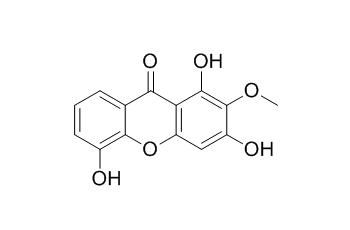Tovopyrifolin C
Tovopyrifolin C is a natural product from Calophyllum venulosum.
Inquire / Order:
manager@chemfaces.com
Technical Inquiries:
service@chemfaces.com
Tel:
+86-27-84237783
Fax:
+86-27-84254680
Address:
1 Building, No. 83, CheCheng Rd., Wuhan Economic and Technological Development Zone, Wuhan, Hubei 430056, PRC
Providing storage is as stated on the product vial and the vial is kept tightly sealed, the product can be stored for up to
24 months(2-8C).
Wherever possible, you should prepare and use solutions on the same day. However, if you need to make up stock solutions in advance, we recommend that you store the solution as aliquots in tightly sealed vials at -20C. Generally, these will be useable for up to two weeks. Before use, and prior to opening the vial we recommend that you allow your product to equilibrate to room temperature for at least 1 hour.
Need more advice on solubility, usage and handling? Please email to: service@chemfaces.com
The packaging of the product may have turned upside down during transportation, resulting in the natural compounds adhering to the neck or cap of the vial. take the vial out of its packaging and gently shake to let the compounds fall to the bottom of the vial. for liquid products, centrifuge at 200-500 RPM to gather the liquid at the bottom of the vial. try to avoid loss or contamination during handling.
BMC Microbiol.2019, 19(1):78
Food Sci Biotechnol.2016, 25(5):1437-1442
Molecules.2019, 24(1):E159
Food Chem.2019, 275:746-753
Anticancer Res.2024, 44(3):1033-1044.
Phytochemistry Letters2017, 449-455
Asian Journal of Chemistry2014, 26(8):2425
Biosci. Rep.2020, 10.1024
Biomolecules.2020, 10(2):E184
Int J Mol Sci.2024, 25(1):616.
Related and Featured Products
Molecules. 2013 Feb 4;18(2):1985-94.
Cytotoxicity and structure-activity relationships of xanthone derivatives from Mesua beccariana, Mesua ferrea and Mesua congestiflora towards nine human cancer cell lines.[Pubmed:
23381024]
The cytotoxic structure-activity relationships among a series of xanthone derivatives from Mesua beccariana, Mesua ferrea and Mesua congestiflora were studied.
METHODS AND RESULTS:
Eleven xanthone derivatives identified as mesuarianone (1), mesuasinone (2), mesuaferrin A (3), mesuaferrin B (4), mesuaferrin C (5), 6-deoxyjacareubin (6), caloxanthone C (7), macluraxanthone (8), 1,5-dihydroxyxanthone (9), Tovopyrifolin C (10) and α-mangostin (11) were isolated from the three Mesua species. The human cancer cell lines tested were Raji, SNU-1, K562, LS-174T, SK-MEL-28, IMR-32, HeLa, Hep G2 and NCI-H23. Mesuaferrin A (3), macluraxanthone (8) and α-mangostin (11) showed strong cytotoxicities as they possess significant inhibitory effects against all the cell lines.
CONCLUSIONS:
The structure-activity relationship (SAR) study revealed that the diprenyl, dipyrano and prenylated pyrano substituent groups of the xanthone derivatives contributed towards the cytotoxicities.
J Asian Nat Prod Res. 2015;17(11):1104-8.
Venuloxanthone, a new pyranoxanthone from the stem bark of Calophyllum venulosum.[Pubmed:
26023810]
METHODS AND RESULTS:
A new pyranoxanthone, venuloxanthone (1), was isolated from the stem bark of Calophyllum venulosum, together with three other xanthones, Tovopyrifolin C (2), ananixanthone (3) and caloxanthone I (4), along with two common triterpenes, friedelin (5) and lupeol (6).
CONCLUSIONS:
The structures of these compounds were identified using several spectroscopic analyses which are NMR, GCMS and FTIR experiments.



